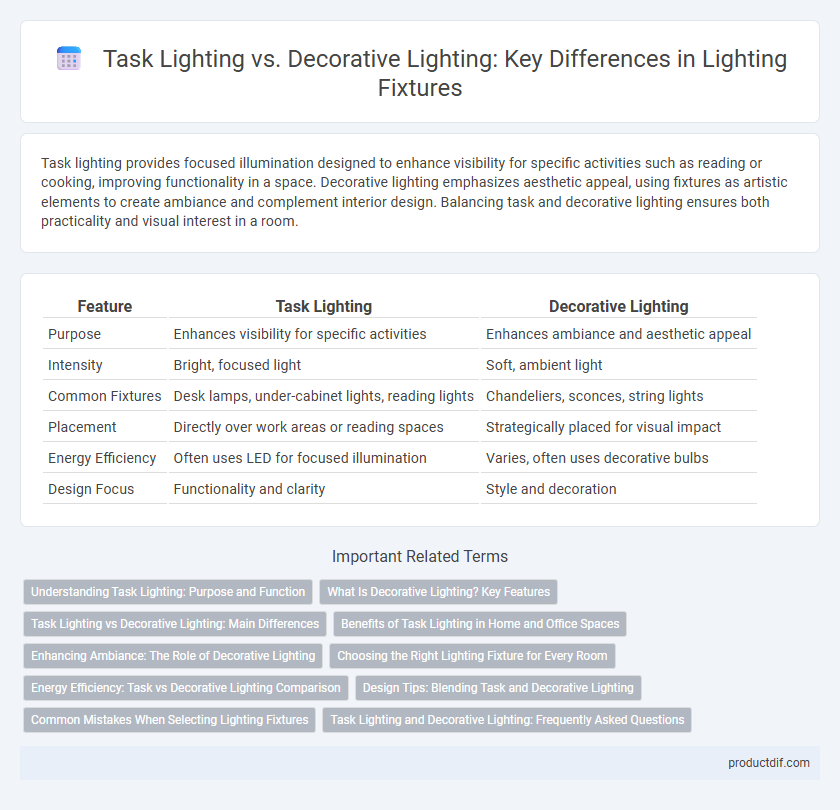Task lighting provides focused illumination designed to enhance visibility for specific activities such as reading or cooking, improving functionality in a space. Decorative lighting emphasizes aesthetic appeal, using fixtures as artistic elements to create ambiance and complement interior design. Balancing task and decorative lighting ensures both practicality and visual interest in a room.
Table of Comparison
| Feature | Task Lighting | Decorative Lighting |
|---|---|---|
| Purpose | Enhances visibility for specific activities | Enhances ambiance and aesthetic appeal |
| Intensity | Bright, focused light | Soft, ambient light |
| Common Fixtures | Desk lamps, under-cabinet lights, reading lights | Chandeliers, sconces, string lights |
| Placement | Directly over work areas or reading spaces | Strategically placed for visual impact |
| Energy Efficiency | Often uses LED for focused illumination | Varies, often uses decorative bulbs |
| Design Focus | Functionality and clarity | Style and decoration |
Understanding Task Lighting: Purpose and Function
Task lighting is designed to provide focused, bright illumination that enhances visibility for specific activities such as reading, cooking, or working at a desk. It improves productivity and reduces eye strain by targeting precise areas with adjustable fixtures like desk lamps, under-cabinet lights, or pendant lights. Unlike decorative lighting, task lighting prioritizes function over aesthetics to create efficient, well-lit workspaces.
What Is Decorative Lighting? Key Features
Decorative lighting enhances the aesthetic appeal of a space by focusing on artistic design and visual impact rather than functionality. Key features include fixtures like chandeliers, sconces, and pendant lights that serve as focal points, using color, shape, and style to complement interior decor. Unlike task lighting, decorative lighting emphasizes ambiance and mood, often incorporating dimmable options and unique materials to create visual interest.
Task Lighting vs Decorative Lighting: Main Differences
Task lighting provides focused, bright illumination designed to aid specific activities such as reading, cooking, or working, ensuring optimal visibility and reducing eye strain. Decorative lighting emphasizes aesthetic appeal, creating ambiance and enhancing interior design through softer, visually pleasing light sources. The main differences lie in functionality--task lighting prioritizes practicality and precision, while decorative lighting focuses on mood and style.
Benefits of Task Lighting in Home and Office Spaces
Task lighting enhances productivity and reduces eye strain by providing focused illumination directly on work areas in home and office settings. It improves concentration and accuracy during activities such as reading, writing, or computer use by minimizing shadows and glare. Effective task lighting also contributes to energy efficiency by allowing users to light only the necessary spaces, reducing overall electricity consumption.
Enhancing Ambiance: The Role of Decorative Lighting
Decorative lighting plays a crucial role in enhancing ambiance by adding warmth, color, and texture to a space, influencing mood and visual appeal beyond mere functionality. Unlike task lighting, which focuses on providing bright, focused illumination for specific activities, decorative lighting uses fixtures like chandeliers, sconces, and string lights to create atmosphere and style. Incorporating LED strips, pendant lights, or tasteful accents can transform interiors, making decorative lighting essential for both residential and commercial design aesthetics.
Choosing the Right Lighting Fixture for Every Room
Task lighting provides focused illumination for activities such as reading or cooking, enhancing visibility and reducing eye strain in specific areas like kitchens and home offices. Decorative lighting emphasizes style and ambiance, using fixtures like chandeliers or sconces to complement interior design and create mood. Selecting the right lighting fixture involves balancing functionality and aesthetics, ensuring each room's purpose is supported while achieving the desired atmosphere.
Energy Efficiency: Task vs Decorative Lighting Comparison
Task lighting prioritizes energy efficiency by using focused, high-intensity LED bulbs that illuminate specific work areas, reducing overall power consumption. Decorative lighting often relies on broader, ambient light sources or incandescent bulbs, which generally consume more energy and produce unnecessary brightness. Choosing LED task lights with adjustable brightness levels can significantly lower energy costs compared to traditional decorative lighting fixtures.
Design Tips: Blending Task and Decorative Lighting
Effective lighting fixture design balances task lighting's focused, high-intensity illumination with decorative lighting's ambient, aesthetic appeal to enhance both functionality and style. Incorporate layered lighting by positioning adjustable LED task lamps near work areas while using pendant or wall sconces in complementary styles to create visual interest without overpowering the space. Selecting fixtures with dimmable features and harmonious finishes allows seamless transitions between practical brightness and cozy ambiance.
Common Mistakes When Selecting Lighting Fixtures
Common mistakes when selecting lighting fixtures for task versus decorative lighting include choosing bulbs with insufficient brightness for task areas, leading to eye strain and reduced productivity. Many also overlook fixture placement, which can cause shadows or glare, negatively impacting both functionality and ambiance. Selecting fixtures solely for aesthetic appeal often compromises the quality of illumination needed for specific tasks, resulting in inefficient lighting solutions.
Task Lighting and Decorative Lighting: Frequently Asked Questions
Task lighting provides focused illumination designed to enhance visibility for specific activities such as reading, cooking, or working, often utilizing LED desk lamps, under-cabinet lights, or adjustable floor lamps. Decorative lighting emphasizes aesthetic appeal and ambiance, featuring fixtures like chandeliers, wall sconces, and pendant lights that complement interior design while providing soft, indirect light. Frequently asked questions about task lighting and decorative lighting revolve around their applications, energy efficiency, and how to balance functionality with style in various living or workspace environments.
Task lighting vs Decorative lighting Infographic

 productdif.com
productdif.com